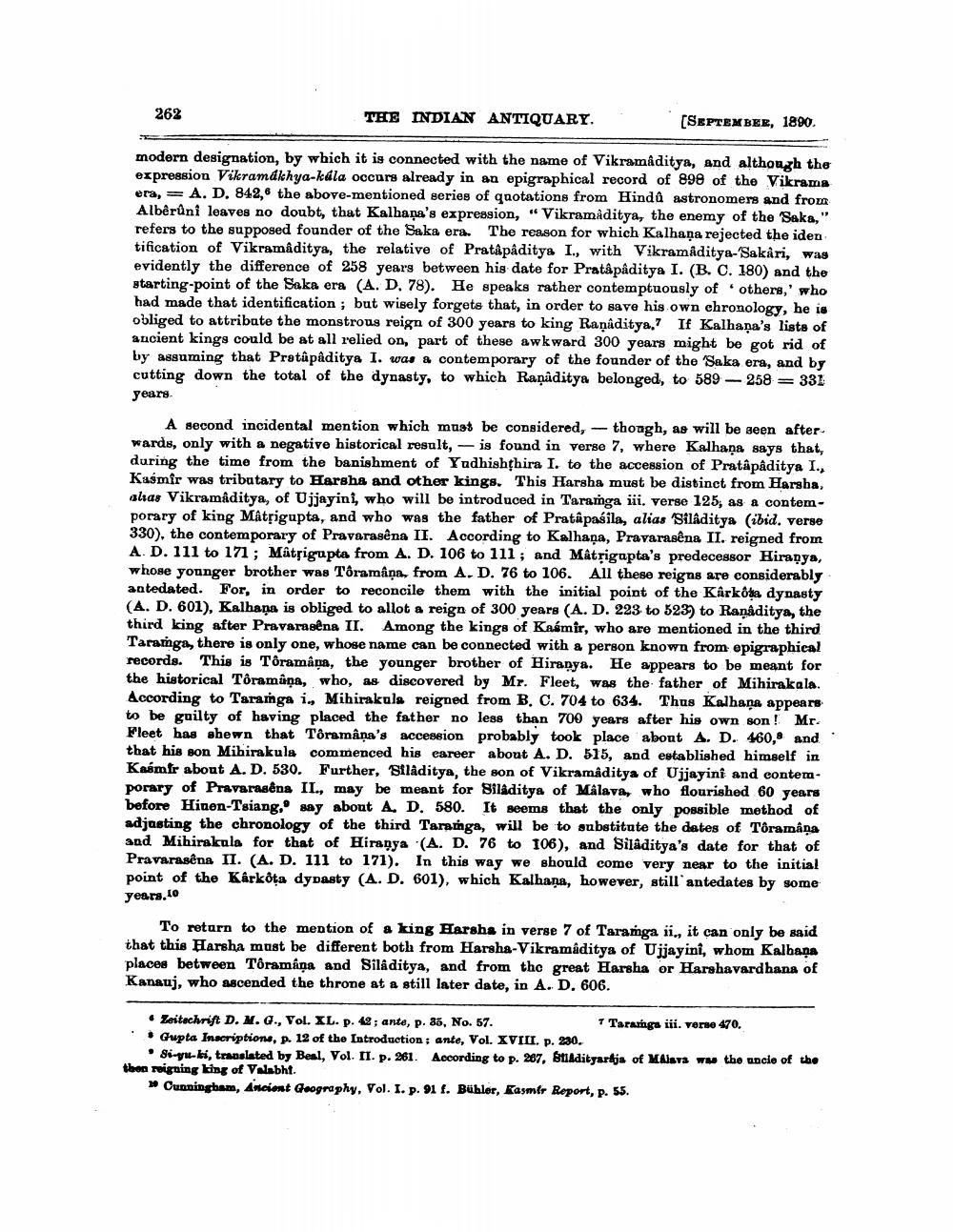________________
262
THE INDIAN ANTIQUARY.
[SEPTEMBER, 1890.
modern designation, by which it is connected with the name of Vikramaditya, and although the expression Vikramdkhya-kala occurs already in an epigraphical record of 898 of the Vikrama era, = A. D. 842, the above-mentioned series of quotations from Hind astronomers and from Albêrûni leaves no doubt, that Kalhaņa's expression, "Vikramaditya, the enemy of the Saka," refers to the supposed founder of the Saka era. The reason for which Kalhaņa rejected the iden tification of Vikramaditya, the relative of Pratápaditya I., with Vikramaditya-Sakari, was evidently the difference of 258 years between his date for Pratâ pâditya I. (B. C. 180) and the starting point of the Saka era (A. D. 78). He speaks rather contemptuously of others, who had made that identification ; but wisely forgets that, in order to save his own chronology, he is obliged to attribute the monstrous reign of 300 years to king Ramaditya.7 If Kalhana's lists of ancient kings could be at all relied on, part of these awkward 300 years might be got rid of by assuming that Pretâpâditya I. was a contemporary of the founder of the 'Saka era, and by cutting down the total of the dynasty, to which Raņâditya belonged, to 589 - 258 = 331 years
A second incidental mention which must be considered, - thoagh, as will be seen after wards, only with a negative historical result, - is found in verse 7, where Kalhana says that, during the time from the banishment of Yudhishthira I. to the accession of Pratâpâditya I., Kasmir was tributary to Harsha and other kings. This Harsha must be distinct from Harsba, alias Vikramaditya, of Ujjayini, who will be introduced in Taramga iii, verse 125, as a contemporary of king Mâtrigupta, and who was the father of Pratâpasila, alias "Siladitya (ibid. verse 330), the contemporary of Pravarasêna II. According to Kalhaņa, Pravarasena II. reigned from A.D. 111 to 171 ; Mâtsigupta from A. D. 106 to 111 ; and Matrigapta's predecessor Hiranya, whose younger brother was Tôramâna, from A. D. 76 to 106. All these reigns are considerably antedated. For, in order to reconcile them with the initial point of the Karköta dynasty (A. D. 601), Kalhana is obliged to allot a reign of 300 years (A. D. 223 to 5239 to Ranaditya, the third king after Pravarnaêna II. Among the kings of Knómir, who are mentioned in the third Taramga, there is only one, whose name can be connected with a person known from epigraphical records. This is Tôramana, the younger brother of Hiranya. He appears to be meant for the historical Tôramana, who, as discovered by Mr. Fleet, was the father of Mihirakala. According to Taramga i., Mihirakula reigned from B. C. 704 to 634. Thus Kalhaņa appears to be guilty of having placed the father no less than 700 years after his own son! Mr. Fleet has shewn that Tôramâna's accession probably took place about A. D. 460,9 and that his son Mihirakula commenced his career about A. D. 515, and established himself in Kasmir about A. D. 530. Further, Siladitya, the son of Vikramaditya of Ujjayini and contemporary of Pravarasens II., may be meant for Siladitya of Málava, who flourished 60 years before Hinen-Tsiang, say about A. D. 580. It seems that the only possible method of adjasting the chronology of the third Taranga, will be to substitute the dates of Tôramâna and Mihirakula for that of Hiranya (A. D. 76 to 106), and Siladitya's date for that of Pravarasena II. (A. D. 111 to 171). In this way we should come very near to the initial point of the Karkota dynasty (A. D. 601), which Kalhaņa, however, still'antedates by some years.co
To return to the mention of a king Harshs in verge 7 of Taranga ii., it can only be said that this Harsha must be different both from Harsha-Vikramaditya of Ujjayini, whom Kalbana places between Tôramana and Siladitya, and from the great Harsha or Harshavardhana of Kanauj, who ascended the throne at a still later date, in A. D. 606.
Zeitechrift D. M. G., Vol. XL. p. 42; ante, p. 35, No. 57.
7 Taranga iii. verne 470. . . Gupta Inscriptione, p. 12 of the Introduction : ante, Vol. XVIII. p. 230.
• Si-yu-ki, translated by Beal, Vol. II. p. 261. According to p. 207, Btiadityartja of Malaya ww the ancie of the then reigning king of Valubht.
* Cunningham, Ancient Geography, Vol. I. p. 91 f. Bühler, Kasmir Report, p. 55.




